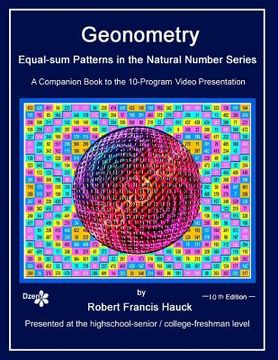Geonometry - Equal-sum Patterns in the Natural Number Series: A companion book to the 10-Part Slide Presentation (in English)
Synopsis "Geonometry - Equal-sum Patterns in the Natural Number Series: A companion book to the 10-Part Slide Presentation (in English)"
Geonometry is essentially the natural geometry hidden in the natural number series. The math only involves addition, subtraction and multiplication of integers. Occasionally division is called for but there are no numbers expressed as decimals and numbers expressed as fractions always lead to whole numbers. The math involves matrices, but not those governed by the rules of Matrix Algebra. It has its own set of rules and formulas that are comparatively very simple. Unlike Matrix Algebra with all its complicated functions, Geonometry involves only two functions from classical math and those are the modulus and integer functions. Those have merely been reformulated to avoid producing 0's. Geonometry uses Microsoft's Excel software entirely. In fact, without Excel, this new math would never have been discovered and developed. Here are some of the amazing properties discovered in Geonometry: 1. In 2-dimensions, every square table consisting of the number sequence 1 thru n-squared has summations which all add up to the same number in 4 directions: i.e. for every row, every column and every major and minor diagonal, including all those diagonals starting between corners that must wrap across the edges going up or down. That number is only dependent upon the size of the square and is called the size's characteristic number. 2. Further, every set of numbers at the four corners of every rectangle and rhombi centered over the very middle of the square, called a quadral, sum equally to a different number too, that is a specific whole-number fraction 4/n of the square's characteristic number. 3. The square tables can be segregated into 6 classes, some with subclasses within them, that have very distinctive properties. All classes of squares have tiling patterns where each interlocking tile sums to the square's characteristic number too or a multiple thereof. 4. Moreover, there are always two different complementary tiling patterns which do so simultaneously for every size of square and class of square. And all the individual tiles in these interlocking tiling patterns sum equally, no matter where their centers are located in the square. 5. Class-3 squares are of sizes that are a 3 times multiple of an odd-prime number b >3. The tiling patterns in these squares are the tiling patterns characteristic of the Class-1 square of size b but in 3-by-3 block-squares and these tiling patterns sum equally everywhere to 3 times the square's characteristic number. 6. In Class-4 squares whose size is a multiple of 4, there is a different kind of tiling pattern formed from a ring-diamond and an X pattern which also sum equally continuously everywhere in the square. 7. The Class-5 squares, which are of a size that is a product of two distinct odd-prime numbers a and b, have block-squares of sizes a and b that sum equally at the block-square level in the complimentary tiling configuration of both Class-1 squares of sizes b and a, respectively, and these 4 simultaneous tiling patterns sum equally everywhere to b or a times, the square's characteristic number. 8. Class-6 squares are squares whose size is a power of an odd-prime number b where n = b to the power of a. There, the tiling patterns are the bxb block-squares in a tiling configuration of the size b Class-1 square which all sum equally to b times the square's characteristic number everywhere in the table. Now each of these "primal" squares in all classes but Class-2 have what is called a "dual" square, each of which can be derived directly from the other by what are called loom tables. These tables are the modulus table and the integer table and are initially derived from the primal square. In fact, they regenerate the primal square according to a very simple formula.

